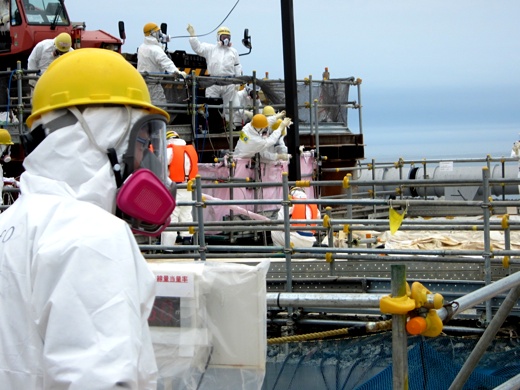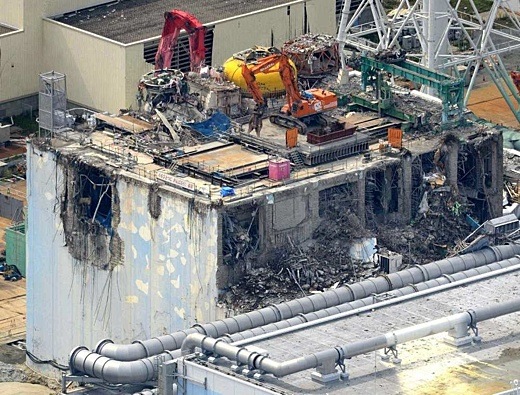By Gayla Groom on 21 July 2012 for Fukushima FAQ -
(http://www.fukushimafaq.info/)

Image above: Workers from Hitachi-GE help remove unused fuel-rod assemblies from Unit #4 at Fukushima Daiichi From (http://photo.tepco.co.jp/en/date/2012/201207-e/120719_01e.html).
On June 11, 2012, Japanese diplomat Akio Matsumura wrote:
Let me clarify briefly why Fukushima Daiichi remains an enormous danger for which no scientists can recommend a solution at the moment….
In reactors 1, 2 and 3, complete core meltdowns have occurred. Japanese authorities have admitted the possibility that the fuel may have melted through the bottom of the reactor core vessels. It is speculated that this might lead to unintended criticality (resumption of the chain reaction) or a powerful steam explosion – either event could lead to major new releases of radioactivity into the environment.
Reactors 1 and 3 are sites of particularly intense penetrating radiation, making those areas unapproachable. As a result, reinforcement repairs have not yet been done since the Fukushima accident. The ability of these structures to withstand a strong aftershock earthquake is uncertain.
The temporary cooling pipes installed in each of the crippled reactors pass through rubble and debris. They are unprotected and highly vulnerable to damage. This could lead to a failure of some cooling systems, causing overheating of the fuel, further fuel damage with radioactive releases, additional hydrogen gas explosions, possibly even a zirconium fire and fuel melting within the spent fuel pools.
Reactor No. 4 building and its frame are seriously damaged. The spent fuel pool in Unit 4, with a total weight of 1,670 tons, is suspended 100 feet (30 meters) above ground, beside a wall which is bulging outward. If this pool collapses or drains, the resulting blast of penetrating radiation will shut down the entire area. At the Fukushima Dai-ichi nuclear power station, the spent fuel pools alone contain an amount of cesium-137 that is 85 times greater than at Chernobyl.The likely result of any one of Fukushima’s problems getting out of hand is that no one can then get close enough to keep the other problems under control, so everything goes; all the problems manifest their worst.
Radiation levels at the complex are so high that many areas are not accessible to people — they would receive a fatal dose within seconds — nor even to robots, whose circuitry is destroyed by the radiation. Experts say that technology to solve Fukushima’s problems does not yet exist.
Recent Events at Fukushima Daiichi M4.5 quake hits Fukushima — Third over 4.o in last 24 hours.
Title: Earthquake Information Source: Japan Meteorological Agency (http://www.jma.go.jp/en/quake/quake_local_index.html)
01:16 JST - 01:11 JST 20 Jul 2012 Fukushima-ken Oki M4.52TEPCO finishes trial removal of unused fuel from Unit No. 4 see (http://english.kyodonews.jp/news/2012/07/170461.html):
19:44 JST - 19:39 JST 19 Jul 2012 Fukushima-ken Oki M4.02
05:43 JST - 05:38 JST 19 Jul 2012 Fukushima-ken Oki M4.01
Tokyo Electric Power Co. said Thursday (July 19th, 2012) it has finished the trial removal of two unused nuclear fuel assemblies from a fuel storage pool at the badly damaged No. 4 reactor unit of its Fukushima Daiichi power plant without any major trouble.
The operation is part of a process toward scrapping the damaged Nos. 1 to 4 units at the six-reactor plant. The utility will first remove fuel from the No. 4 unit, because its pool stores the largest number of fuel rods and its building has no roof due to a hydrogen explosion in March 2011.
The utility known as TEPCO will carry out a more detailed inspection of the two assemblies, which are bundles of fuel rods about 4 meters long and each weighing some 300 kilograms. But spokesman Junichi Matsumoto told a press conference that no major deformation or corrosion had been observed so far.Some reports say the relatively less radioactive "fuel units" are being removed not as a test preparatory to removing more fuel, but in order to see how damaged the fuel units are are, and that no large-scale fuel removal is being contemplated until December 2013 or later.
According to the New York Times, the reactor 4 building contains 1,331 spent and 204 unused nuclear fuel assemblies, and each assembly contains approximately 50 to 70 rods, meaning there are at minimum 66,550 fuel rods in Reactor Building #4.
Degraded Unit #4
SUBHEAD: Tepco's Reactor 4 at Fukushima Daiichi is in structural danger of collapse.
By Yoishi Shimatsu on 7 July 2012 for Rense -
 Image above: Recent photo of Fukushima Daiichi Unit 4 building shows some of the damage to structure. From original article.
Image above: Recent photo of Fukushima Daiichi Unit 4 building shows some of the damage to structure. From original article.A few years ago, I had to make a decision to either restore an old school building in Hong Kong for an environmental center - or demolish it. The long concrete structure was built atop a garbage dump, and the final decision was demolition due to uneven sinkage. Whenever heavy buildings are not foursquare and level, massive internal stresses build up and rip the structure apart. In a recent helicopter photo of Reactor 4, seen from the east (ocean side), there are similar signs of building sinkage.
Along the middle-to-northeast corner (right side), cross beams have fallen out, and at least two adjoining pillars are of different height. The outer wall panels cracked and fell off as a result. (Plus one can see clear through from the east to northeast through a gaping hole.) Cross beams snap off due to the displacement of pillars in opposite directions
What the combination indicates is that the footing of the structure has cracked completely, with two-thirds of the building sinking at a slight angle into the broken edge, while the smaller north side, relieved of load, gradually rises with a series of popping noises. This springboard effect is audible whenever a column lurches upward, like the two pillars o n the right-hand side lifting the floor above it and breaking out. (The pincher-clawed back-hoe is parked on a pad that spreads the weight over the precarious structure.)
It is very probable that the reactor below is tilting as well. The concrete footing for the structure is too thick to crack under weight alone or even in a major quake, and so the cleavage was probably caused by the corium searing along a line. Once burned, the concrete and rebar lose their strength and can buckle and crack under seismic vibrations and weight from above - especially if the ground is unstable.
The March 11 quake probably caused liquefaction that opened an empty pocket below the footing, and water seepage from the tsunami, rainstorms and coolant leakage subsequently eroded the soil. Since the spent fuel pools are on the south side, the strongest end of the broken structure, one metal tank still appears to be intact, judging from the corner that can be seen. The twisted, overheated metal leaning out of the holes around the spent fuel pool indicate the framework under the pool is wrecked. If the pools are still level, it would be nothing short of miraculous.
Odds are that the pools are tilting, adding massive stress to the whatever remains of the supporting frame. The steel plate over the now-exposed floor/ceiling could be there to prevent people from seeing that the spent fuel pool is tilting and lower than its former position due to the bending of the metal frame below. A tarp would have been melted by the heat released from the jostling of the pool and loss of water in the two series of 2012 quakes that further degraded the structure. Two sheets of steel plate could resist temperature build-ups of up to about 1,000 C or around 2,000 F before bending. Notably, open space is left on either side of the plates to allow heat escape.
The presence of the plates point to flaring temperatures on occasion since the spent pool fires of March 14 and 16, 2011. The demolition work of June 26 had to be done to remove the weight of the upper walls. This is consistent with what must be done when the footing is cracked and lower floors are tilting inward, causing stress buildup throughout the entire fabric of the structure. That old school building rocked like a boat whenever a bus or truck passed by on the adjoining road. For Fukushima workers, it would be terrifying to be on top of a fractured structure that amplifies seismic waves.
The ongoing self-destruction is inexorable and cannot be repaired or reversed. When I checked the foundation of the old school structure, the concrete was broken clean through in many places along roughly parallel lines. Fixing a broken foundation is impossible, especially when it is on uneven landfill, since the rubble below will firmly not hold up an injection of concrete or jacking. Our team considered the possibility of artificial support for that school building but quickly gave up the idea as unfeasible. The far heavier Reactor 4 structure is following the same pattern of step-by-step degradation, or phased collapse, in which the stress factors are so complex that there is no way to predict when or what part will be the next to go.
The rate of soil loss under the structure is still the determining factor leading to a final collapse, and this problem of soil sinkage effects the entire Fukushima No.1 plant site, which rests on landfill compromised by quake-caused liquefaction, erosion by the tsunami, incessant water leakage and melt-through of escaped nuclear fuel. Engineers therefore had to push back the TEPCO plan to remove two fuel rods from Reactor 4 in this month of July. For the same reason of soil instability no attempt has been made to set up a scaffolding or crane along the south wall to lift rods into a casket. Instead of an apocalyptic moment, as most observers had anticipated, the ongoing degradation of Reactor 4 remains one of nerve-racking suspense, of waiting for the next beam to drop.
• Yoichi Shimatsu is an environmental writer and consultant based in Southeast Asia.
.
1 comment :
interesting blog. It would be great if you can provide more details about it. Thanks you
Pool Demolition
Post a Comment